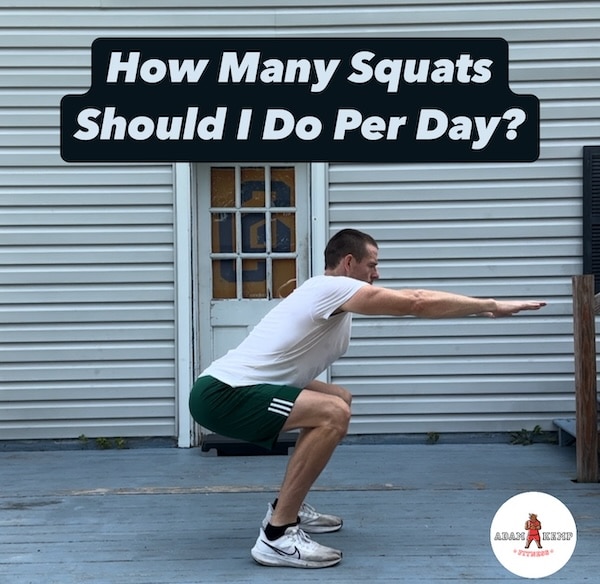How Many Squats Should I Do a Day?
Determining how many squats you should do a day depends on your fitness goals, experience level, and overall workout plan.
As someone who has spent years experimenting with different squat routines, I can confidently say that squats are one of the most effective exercises for building strength, conditioning, and functional fitness.
However, it’s essential not to overdo it and to structure your squat routine wisely.
Throughout my basketball career, I’ve experimented with various squat routines. At one point, I pushed myself to do 25 sets of 25 air squats in a single day, totaling 625 squats.
I’ve also completed 100 barbell squats at 135 lbs in 4-6 sets, taken on the challenge of “20 rep squats” with up to 185 lbs, and lifted as heavy as 315 lbs for ten sets of 3 reps.
These routines gave me excellent conditioning and functional strength, but I’ve also dealt with back issues over the years (although mostly from basketball incidents rather than squatting).
While squats have been a cornerstone of my training, I’ve learned that moderation is key.
Overdoing squats—or any part of your regimen—can lead to strain and potentially hinder your progress.
How Many Squats Should You Do Per Day?
A well-rounded squat routine doesn’t require daily squats. In fact, 2 days of squats per week is an ideal approach for most people.
This allows your muscles to recover while still providing enough stimulus to build strength and endurance.
On one day, you can focus on heavy back squats with lower reps to build maximum strength.
On another day, incorporate lighter squats like goblet squats with higher reps to improve muscle endurance and functional strength.
General Recommendation
The most squats you should do in a day depends on your fitness level, goals, and experience. For most people, a safe and effective range is between 50 to 100 air squats spread throughout the day, especially if you’re new to squatting or focusing on endurance.
If you’re more experienced and looking to build strength, you might do 3-5 sets of 10-20 reps of weighted squats, like goblet or back squats.
However, pushing beyond 200 squats in a day, especially with added weight, can increase the risk of injury, so it’s crucial to listen to your body and avoid overtraining. Balancing squat volume with adequate rest and recovery is key to long-term progress and avoiding burnout.
Examples of High-Rep Squat Workouts
One Punch Man Workout
The One Punch Man workout, inspired by the anime character from One Punch Man, is a fictional yet intense regimen that has gained popularity for its simplicity and extreme challenge.
It consists of 100 push-ups, 100 sit-ups, 100 squats, and a 10-kilometer run every day without rest days.
In this regimen, the squats are a significant part of the workout, with 100 squats included daily.
This high volume of squats is designed to build endurance and strength but can be quite demanding on the body, especially when done consistently without rest.
While the Saitama workout is more of a fun challenge than a scientifically backed training program, it highlights the importance of consistency and pushing personal limits.
However, it’s crucial to recognize that such a workout can lead to overtraining, especially if you’re not used to high-repetition exercises.
For most people, gradually building up to this volume, incorporating rest days, and listening to your body’s signals are essential to avoid injury and achieve sustainable results.
Military-Style Workouts

United States military workouts are renowned for their intensity, discipline, and focus on functional strength and endurance. These workouts often emphasize bodyweight exercises, high-repetition sets, and minimal rest, designed to build mental toughness, muscular endurance, and overall physical resilience.
A typical U.S. military workout might include hundreds of push-ups, pull-ups, sit-ups, and body squats, often done in circuits with little to no rest between exercises. The goal is to push the body to its limits and simulate the physically demanding conditions that they may encounter in the field.
When it comes to body squats, U.S. soldiers often perform 200 to 300 squats in a single session, often broken into multiple sets with varying rep ranges. These high volumes are intended to build leg strength and endurance, crucial for the intense physical demands of their missions.
High-Rep Body Squat CrossFit-Style Workouts
In CrossFit, body squats are often incorporated into high-intensity workouts that aim to build strength, power, and cardiovascular endurance. While CrossFit typically focuses on a wide range of functional movements, body squats can be a central component in workouts like “Cindy,” “Angie,” or “Murph,” where participants perform large volumes of bodyweight exercises as quickly as possible.
For example, in a workout like “Cindy,” athletes complete as many rounds as possible (AMRAP) in 20 minutes of 5 pull-ups, 10 push-ups, and 15 air squats. Depending on the athlete’s pace, this could result in performing anywhere from 150 to over 300 air squats in a single workout.
In terms of max efforts, some CrossFit workouts challenge athletes to perform as many body squats as possible in a set time, such as a 10-minute max air squat test, where elite CrossFit athletes might achieve 400 or more squats.
However, it’s important to approach these high volumes with caution, as they can lead to fatigue and form breakdown, increasing the risk of injury if not done with proper technique.
EMOM Workouts
EMOM (Every Minute on the Minute) workouts are highly effective for building strength and conditioning while maintaining a high level of intensity. In an EMOM workout, you perform a specific number of reps at the start of every minute, resting for the remainder of the minute before beginning the next set. When using squats in an EMOM format, you can adjust the intensity by varying the type of squat and the number of reps. For example:
- Bodyweight Squats EMOM: Perform 15-20 air squats every minute for 10-20 minutes. This setup emphasizes endurance and keeps your heart rate elevated.
- Med Ball Squats EMOM: Holding a medicine ball, perform 10-15 squats every minute. The added weight increases the resistance, providing more strength-focused training.
- Light Kettlebell Squats EMOM: Using a light kettlebell, perform 8-12 goblet squats every minute. This version challenges both your lower body strength and core stability.
EMOMs are versatile and can be scaled to suit different fitness levels. They are particularly effective for building endurance in a controlled, time-efficient manner.
21-15-9 Workouts
The 21-15-9 rep scheme is a staple in CrossFit, designed to test your ability to maintain intensity across multiple rounds of decreasing reps. In this format, you perform 21 reps of each exercise, then 15 reps, and finally 9 reps, often aiming to complete the workout as quickly as possible.
For example, a 21-15-9 workout might include:
- Bodyweight Squats: Perform 21 air squats, followed by 21 reps of another exercise (like push-ups), then 15 squats, and so on. This format challenges your muscular endurance and ability to push through fatigue.
- Med Ball Squats: Using a medicine ball, complete the 21-15-9 sequence. The added weight of the med ball increases the challenge for your legs and core.
- Light Kettlebell Squats: Perform the squats with a kettlebell in the goblet position. This increases the difficulty and adds a functional strength component to the workout.
The 21-15-9 format is excellent for improving work capacity, as it forces you to maintain high intensity even as the rep count decreases. It’s a great way to mix in different types of squats while also challenging other muscle groups and your cardiovascular system.
Safety Tips & Keys to Sucess with Squats
Squats are a powerful tool for building strength and conditioning, but it’s crucial to avoid overdoing it. A balanced approach with two days of squats per week, varying between heavy and light days, is an effective way to achieve your fitness goals without risking injury.
Start with air squats, progress to goblet squats, and eventually work your way up to barbell squats. By doing this, you’ll build a strong foundation, improve your overall fitness, and stay injury-free.
Incorporating squats into your routine is essential, but like any exercise, they should be done in moderation and with proper form. Listen to your body, and remember that consistency and variety are key to long-term success.
Here is some more information:
Start with the Basics
If you’re new to squats, start with air squats. These bodyweight exercises are perfect for building a solid foundation and ensuring your form is correct.
Once you’ve mastered air squats, progress to goblet squats using a dumbbell or kettlebell.
Goblet squats are excellent for developing core stability and leg strength while still being easy on the back.
Progress to Heavier Lifts
As you build confidence and strength, you can start incorporating front squats and back squats with a barbell. These exercises allow you to lift heavier weights and further develop your leg muscles.
However, it’s important to keep the volume and intensity in check. A routine like 5×5 squats, where you do five sets of five reps, is a great strength-building workout that works well for both beginners and experienced lifters.
Variety Is Key
Incorporating different types of squats into your routine is beneficial not only for muscle development but also for preventing overuse injuries.
You might try a 3×5 or 5×3 routine for back squats or experiment with the 5-3-1 method, which involves varying the rep and weight schemes each week to keep your body adapting.
Don’t Forget Conditioning
While heavy squats are essential for building maximum leg strength and overall athleticism, lighter, high-repetition squats or HIIT-style squat workouts with dumbbells or kettlebells are excellent for conditioning and functional fitness.
For additional speed and power development, you could even progress to jump squats.
These exercises help improve endurance and agility, making them a valuable addition to any training program.
This website does not provide medical advice. This website site does contain affiliate links, and purchases may earn a commission.
Read my Medical Disclaimer, Review Disclaimer, and Publishing Policies for more details. Use of this site indicates acceptance of these terms.



